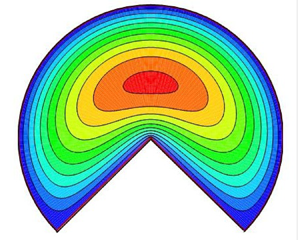Article contents
Turbulent flows along a streamwise external corner
Published online by Cambridge University Press: 06 April 2022
Abstract

A numerical investigation of turbulent flows in straight pipes with a cross-section in the form of a circular sector at different values of the apex angle  ${\alpha }$ is carried out. Main attention is paid to the cases
${\alpha }$ is carried out. Main attention is paid to the cases  ${\alpha }>{\rm \pi}$ when the cross-section boundary contains a convex external corner. An analytical solution to the problem of laminar flow in the geometry under consideration is given. The law of resistance is determined, and velocity distributions over the pipe cross-section are obtained. The singularity of wall shear stress
${\alpha }>{\rm \pi}$ when the cross-section boundary contains a convex external corner. An analytical solution to the problem of laminar flow in the geometry under consideration is given. The law of resistance is determined, and velocity distributions over the pipe cross-section are obtained. The singularity of wall shear stress  $\tau _w\sim r^{{\rm \pi} /{\alpha }-1}$ at
$\tau _w\sim r^{{\rm \pi} /{\alpha }-1}$ at  ${\alpha }>{\rm \pi}$ is shown which persists in turbulent flows as well. Turbulent flows are simulated at
${\alpha }>{\rm \pi}$ is shown which persists in turbulent flows as well. Turbulent flows are simulated at  $Re=2000$ and four apex-angle values
$Re=2000$ and four apex-angle values  ${\alpha }=5{\rm \pi} /4$,
${\alpha }=5{\rm \pi} /4$,  $3{\rm \pi} /2$,
$3{\rm \pi} /2$,  $7{\rm \pi} /4$ and
$7{\rm \pi} /4$ and  $2{\rm \pi}$, as well as at a larger
$2{\rm \pi}$, as well as at a larger  $Re=4000$ and
$Re=4000$ and  ${\alpha }=3{\rm \pi} /2$. The characteristic features of the mean-velocity distributions are outlined, and their relationship with secondary flows is shown. The velocity of the secondary flow in the vicinity of the external corner reaches the value
${\alpha }=3{\rm \pi} /2$. The characteristic features of the mean-velocity distributions are outlined, and their relationship with secondary flows is shown. The velocity of the secondary flow in the vicinity of the external corner reaches the value  $6.3\,\%$ of the bulk flow velocity at the maximum
$6.3\,\%$ of the bulk flow velocity at the maximum  ${\alpha }=2{\rm \pi}$. A characteristic feature of the considered flows is the presence of intense transverse velocity fluctuations in the region above the apex corner. It is hypothesized that the cause of these fluctuations may be the linear instability of the mean flow field. The studies of linear stability confirm this hypothesis. Considerable attention is paid to the study of secondary flows in the vicinity of the external corner. In general, the formation of these flows fits into the scheme proposed earlier (Nikitin, J. Fluid Mech., vol. 917, 2021, A24; Nikitin et al., Fluid Dyn., vol. 56, issue 4, 2021, pp. 513–538), according to which the main mechanism is the centrifugal force arising from the fluctuating flow over the corner in the transverse plane. It is shown that the shape of secondary flows is reproduced to a certain extent by the vortical part of the Reynolds-stress force field. The latter may be found from the Helmholtz decomposition. The features of the mean pressure distribution associated with the secondary flow and with the presence of a region of concentrated fluctuations above the external corner are explained.
${\alpha }=2{\rm \pi}$. A characteristic feature of the considered flows is the presence of intense transverse velocity fluctuations in the region above the apex corner. It is hypothesized that the cause of these fluctuations may be the linear instability of the mean flow field. The studies of linear stability confirm this hypothesis. Considerable attention is paid to the study of secondary flows in the vicinity of the external corner. In general, the formation of these flows fits into the scheme proposed earlier (Nikitin, J. Fluid Mech., vol. 917, 2021, A24; Nikitin et al., Fluid Dyn., vol. 56, issue 4, 2021, pp. 513–538), according to which the main mechanism is the centrifugal force arising from the fluctuating flow over the corner in the transverse plane. It is shown that the shape of secondary flows is reproduced to a certain extent by the vortical part of the Reynolds-stress force field. The latter may be found from the Helmholtz decomposition. The features of the mean pressure distribution associated with the secondary flow and with the presence of a region of concentrated fluctuations above the external corner are explained.
- Type
- JFM Papers
- Information
- Copyright
- © The Author(s), 2022. Published by Cambridge University Press
References
REFERENCES
- 2
- Cited by





